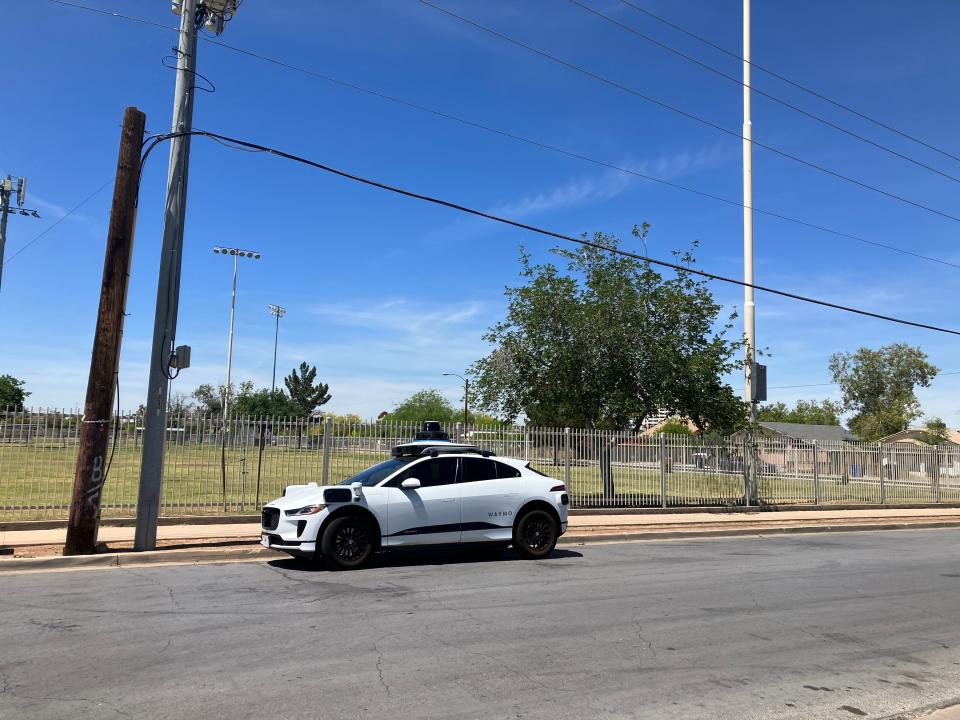Waymo vehicles may have broken traffic laws in Arizona. Now the feds are investigating
The National Highway Safety Administration announced Tuesday it is opening an investigation into Waymo over unexpected behavior from its automated driving systems.
According to a notice posted by the National Highway Traffic Safety Administration’s Office of Defects Investigation, the office is opening a preliminary evaluation into Waymo after receiving reports of 22 incidents where a Waymo vehicle was either the sole vehicle operating during a collision or when the driving system operated in a way that potentially violated traffic laws.
The notice listed 18 reports of incidents that were included in the investigation. Of those 18, eight reports were from Arizona, nine were from California, and one was not yet listed in the NHTSA database, so location was not given.
No injuries were reported in any of the incidents.

Incidents in Arizona included:
A vehicle colliding with a fixed object while making a right turn.
A vehicle getting damaged in a construction zone.
A vehicle colliding with an automatic gate in a parking lot.
A vehicle hitting a chain in a parking lot.
A vehicle hitting spikes in a parking lot entrance.
A vehicle hitting a rock on the road.
A vehicle colliding with a gate in an apartment.
A vehicle hitting debris in the road.
A Waymo spokesperson said in a written statement that the company is proud of its safety record.
“At Waymo, we currently serve over 50,000 weekly trips for our riders in some of the most challenging and complex environments,” the Waymo spokesperson said. “We are proud of our performance and safety record over tens of millions of autonomous miles driven, as well as our demonstrated commitment to safety transparency. NHTSA plays a very important role in road safety, and we will continue to work with them as part of our mission to become the world’s most trusted driver.”
Waymo and other autonomous vehicle operators are required to report incidents to the National Highway Traffic Safety Administration involving a vehicle in autonomous mode, regardless of the vehicle’s role in the incident and the amount of damage, if any.
According to the notice posted Tuesday, the office is investigating Waymo’s 5th-generation automated driving system to assess commonalities in the incidents and evaluate the system’s performance in detecting and responding to traffic control and avoiding collisions with objects and vehicles.
Phoenix is Waymo’s largest market and has the largest contiguous autonomous vehicle operation area in the world, a total of about 225 square miles.
According to data released by Waymo in December 2023, Waymo vehicles avoid injury-causing collisions better than human drivers. According to their research, which was peer-reviewed by experts outside the company, Waymo vehicles were involved in 0.4 collisions with injuries per million miles driven, compared with humans who were involved in 2.78 injury-causing crashes per million miles.
Who owns Waymo?
Waymo is a subsidiary of Google's parent company, Alphabet. Before being called Waymo, it was called "Google's self-driving car project."
What cities is Waymo in?
Waymo operates in four metros. Rides are available to the public in Phoenix and San Francisco and are rolling out in Los Angeles, where interested riders can join the waitlist to start using the service. In August 2023, Waymo announced Austin as its fourth city. Interested riders can join the waitlist for service in Austin.
Phoenix is Waymo's largest coverage area, with about 225 square miles included in the service area. That includes large portions of Phoenix, Scottsdale, Tempe, Chandler and Mesa.
How do Waymos work?
Waymo’s technology uses a system of sensors, computers, and light detection and ranging, known as Lidar, to locate all objects around the car. According to Waymo, each vehicle has 29 cameras, which offer a 360-degree view. The car’s computer system, the “brain” of the vehicle, processes all the information from the sensors and cameras in real-time to make decisions about how the car will move.
Reach the reporter at cvanek@arizonarepublic.com. Follow her on X, formerly Twitter @CorinaVanek.
This article originally appeared on Arizona Republic: Federal government investigating Waymo's autonomous driving systems

